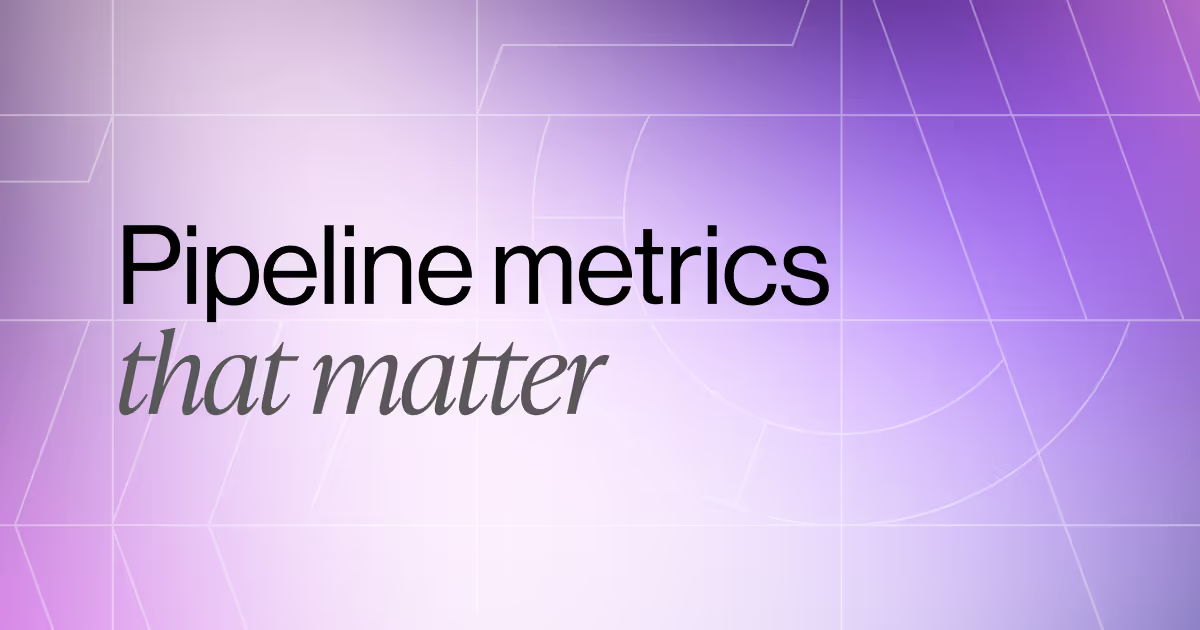How to Build a Sales Pipeline: Complete Step-by-Step Guide for 2025
It’s the start of a new quarter, and your sales team just landed three promising leads that could help you exceed this year’s goals. Everyone's excited, but without a defined sales pipeline with clearly defined stages for each opportunity to go through, things can get messy fast.
Right now, every rep has a different process for qualifying leads, and there's no clear system for tracking conversations. Nobody can say with confidence which deals are moving forward and which have gone cold. This makes forecasts guesses at best, which is particularly challenging when your CEO comes asking for reliable numbers to take to potential investors.
Selling without a pipeline leads to scattered data, inconsistent follow-ups, and very little visibility into what actually drives deals forward. For a small company trying to grow, you need efficient structures to set you up for success. Otherwise, you risk wasting your limited resources. A sales pipeline gives you the structure you need to organize opportunities and turn scattered selling activity into a repeatable process that scales.
What Is a Sales Pipeline?
A sales pipeline is the sequence of steps sellers take to move prospects from initial contact to closed deal. In some cases, it also includes customer onboarding and deal expansion. A sales pipeline organizes opportunities in clearly defined stages, making it easier to spot bottlenecks, track performance, and prioritize high-value deals.
Unlike a sales funnel, which measures how many leads come in and how many convert, the pipeline zeroes in on the process. It emphasizes the seller’s actions (e.g., prospecting, qualifying, presenting solutions, negotiating) that directly influence outcomes in the customer journey, introducing visibility and accountability.
Each stage of the sales pipeline is anchored by a set of activities (e.g., lead qualification or proposal writing) and clear exit criteria that determine when a deal moves forward. No two sales pipelines look exactly alike. The right design depends on your product or service, who you sell to, your sales cycle, and the market dynamics you’re operating in.
For sellers at scaling businesses and startups, a sales pipeline provides a foundation for sustainable growth that solidifies their presence in the market.
Prerequisites for Building Your Pipeline
Before you map out the stages of your pipeline or load prospects into a CRM, you need the right foundation. These prerequisites make it so your pipeline reflects both your business goals and the reality of your customers’ buying process.
Define Your Ideal Customer Profile (ICP)
An ideal customer profile (ICP) gives your team focus. With one, they can prioritize accounts that are a true fit, making prospecting more efficient and data-driven. Without one, sellers end up chasing every conversation and burning cycles on deals that will never close.
To create an ICP, document firmographics (e.g., company size, industry, location), budget ranges, common pain points, and buying signals for your target customer. Your CRM data, market interviews, and customer surveys can serve as inputs. Review the information available to you to create a comprehensive profile that your team (and your marketing and customer success teams) can align on.
For scaling sales teams, it's best to start narrow to keep your sales activities efficient. Identify the customer segment that's most likely to buy in the next six months. Then, as your business matures, you can expand your ICP to reflect new industries, deal sizes, or geographies.
Map Your Customer Journey
Understanding your customer journey is essential so your pipeline reflects reality. Map where and how buyers interact with your company to design a pipeline that standardizes the sales experience and removes roadblocks before they appear.
To get started, outline three to five common touchpoints in a typical deal. For example, visiting your website, requesting a demo, evaluating a proposal, and reviewing terms with stakeholders. As you build your pipeline, establish seller actions that correspond to each step, like sending a nurture email, scheduling a demo, or answering FAQs around the proposal. This way, you'll have a clear set of activities that line up with what your buyer expects at each step.
As you map out the customer journey, ask your marketing and customer success teams to help validate your assumptions across the full lifecycle. With this added clarity, you'll be able to facilitate smoother transitions between stages, helping your team deliver a consistent and predictable buying experience.
Identify Key Stakeholders in the Buying Process
Most B2B deals involve multiple decision-makers. Missing even one of those stakeholders can stall your deal indefinitely. While every company’s buying process looks a little different, there’s consistency in the types of roles you’ll encounter: the economic buyer who controls budget, the technical evaluator who checks for fit, and the inevitable blockers who can slow things down. Identify these players early by looking back on past deals, reaching out to contacts at potential customer organizations, and researching buying practices. With this insight, you'll be able to build repeatable processes for how your team navigates each stage of the pipeline.
Beyond identifying stakeholders, you'll also need a strategy for finding your champions. These are the people in the account who believe in your solution or product and are willing to advocate for it. It could be someone you have an existing relationship with, the person whose pain points you are best suited to solve (which you'll know as part of your ICP), or someone who is strategically positioned to push the deal forward. You'll find these through your existing relationships or by paying close attention and asking the right questions once you get past the lead qualification stage. Once you know who they are, nurture that relationship so that they are primed to support you throughout the deal.
Set Revenue Goals and Targets
A sales pipeline is ultimately a tool to help you reach and exceed your revenue goals. If you don't tie pipeline activity back to clear targets (e.g., number of deals required to reach your quarterly revenue goal), then it becomes an exercise in busywork rather than a driver for growth. With clearly set revenue goals, every step of your pipeline has a purpose, and your team knows what they're working toward.
To set these goals, start with your annual revenue target. Then use your average deal size and historical win rates to calculate how many opportunities you’ll need at each stage.
It’s also critical to connect these targets with your incentive structure. According to CaptivateIQ's State of Incentive Compensation Report, more and more companies are tying incentives to behaviors and business goals like customer expansion, product adoption, and long-term value. When quotas and compensation plans are aligned to pipeline milestones, reps stay motivated to move deals forward consistently rather than chasing short-term wins.
Step-by-Step Pipeline Building Process
With the groundwork in place, it’s time to build your pipeline. This will be the blueprint for how your sellers engage buyers at every step. The process doesn’t have to be complicated, but it does need to be clear and repeatable.
Step 1: Take Stock of Your Prospective Buyers
Start by creating a list of prospective buyers that match your ICP. For small teams, this might mean consolidating contacts from spreadsheets, email lists, and rep notes into a single shared system like a CRM. Include details like company size, industry, role, and any signals that suggest they’re a fit. This exercise helps you understand the volume and quality of leads available, confirming your pipeline isn’t just a theoretical framework and that your service or product has a place in the market.
Step 2: Set up Your Sales Pipeline Stages
Your pipeline stages represent the journey every deal takes from initial contact to close. While naming conventions vary, most sales organizations use a version of the following eight stages.
1. Customer research and lead generation: This stage identifies companies and buyers who match your ideal customer profile. For small sales teams, lead generation often happens through a mix of inbound and outbound activities: publishing content that draws in prospects, sending cold emails, networking at events, or leveraging referrals. The goal is to curate a list of qualified leads who are most likely to convert.
2. Lead qualification: Using a methodology like the BANT framework — budget, authority, need, timeline — you can quickly determine whether a lead is worth pursuing. For example, a lead who has the right budget and urgent need but no decision-making authority may not be a strong candidate unless you can connect with the actual buyer.
3. Needs analysis/discovery: Sales professionals dig into the prospect's pain points, goals, and success criteria to build a deep understanding of the potential buyer's business challenges and whether their product can solve them. Typical activities include discovery calls, stakeholder interviews, and solution mapping exercises.
4. Demo or presentation: The seller takes what they’ve learned and maps it against the solution they offer. This often involves a tailored demo or presentation that highlights how the product solves the buyer’s specific challenges.
5. Proposal: This stage involves presenting a proposal that outlines pricing, terms, and deliverables. This is then circulated to the buying or procurement committee, with the option to address any lingering questions around scope or payment terms.
6. Negotiation: Negotiation is common, and sellers should anticipate objections — whether it’s about cost, implementation, or contract length. Each negotiation your team goes through will be customized to the prospect's requests. That said, your team should still have a standard approach to handling these conversations, with templated scripts and FAQs for them to leverage.
7. Closing: At this point, the buyer is ready to move forward, and the seller’s role is to make the final steps seamless. Tools like e-signature platforms eliminate friction and shorten the sales cycle. It’s also wise to confirm the next steps for onboarding before signing the contract.
8. Post-purchase, onboarding, and upsell: The deal may be closed, but the pipeline doesn’t end here. Post-sale follow-up makes the customer feel supported and helps them see value quickly. This could involve a formal handoff to customer success, scheduled check-ins, or feedback surveys. A strong follow-up process not only improves retention but also creates opportunities for upsell and cross-sell.
It may be tempting to pick a sales pipeline template and follow it, but it's better to take your time to choose the five to eight stages that make the most sense for your business. What you need is alignment and clarity within your sales team on the best possible path a deal takes from initial contact to closed business.
Step 3: Assign Sales Activities and Exit Criteria for Each Stage
A sales pipeline is only doing its job if your reps know what actions are required at each stage — and what needs to happen for a deal to move forward. Defined sales activities further determine the status of a deal in the pipeline, and exit requirements prevent deals from moving forward prematurely. They also promote accountability, ensuring sellers are completing the right activities before advancing deals.
For example, in the discovery stage, the activity might be a 30-minute call, and the exit criteria could be a completed discovery form logged in your CRM. This level of clarity reduces subjectivity and introduces consistency across the team.
These listed activities and criteria also serve as a built-in sales coaching tool: If deals are stalling, managers can see whether reps are executing the right steps or skipping key actions, and support them appropriately.
Step 4: Decide on Your Ideal Pipeline Size
How many deals should you have in your pipeline at any given time? The answer depends on your revenue targets, win rates, and average deal size. Work backward from your goals to calculate the number of opportunities you need. For example, if your team needs to close five deals this quarter, and your win rate is 25%, you’ll need 20 qualified opportunities in the pipeline. This calculation keeps your pipeline sized appropriately, with enough prospects to hit targets, but not so large that your existing reps are spread too thin chasing unqualified leads.
Step 5: Define Your Sales Pipeline Metrics
To keep your pipeline honest, you need metrics that measure progress. Start with core KPIs like pipeline velocity, stage-by-stage conversion rates, average deal size, and sales cycle length. These metrics give you a holistic view of pipeline health. You'll have clarity on how fast deals are moving, where they’re stalling, and whether the volume and value of opportunities are sufficient to hit your targets.
Metrics also make forecasting more reliable by replacing subjective rep estimates with hard data. It creates consistency within your sales team and primes them to scale into a more mature organization that requires a shared language around performance and potential wins.
Step 6: Maintain the Health of the Pipeline
Regular reviews will help you spot and remove stale deals, check data hygiene, and verify that reps are following stage activities consistently. Make pipeline health management a habit with weekly one-on-ones or team reviews, where managers and reps walk through opportunities in the pipeline together. For small companies, this discipline creates shared accountability and keeps forecasts accurate while ensuring that processes remain consistent even as deal volume increases.
Pipeline Management Best Practices
Keeping your pipeline healthy is where the real work lies. These best practices will set up your pipeline to reflect reality and support accurate forecasting.
Regular Pipeline Reviews and Updates
Pipelines are dynamic. Deals move forward, stall, or fall out entirely, and your system needs to reflect that. Regular pipeline reviews help managers and reps align on deal status and next steps. Just as importantly, they provide an opportunity to get rid of stale deals that exceed your average sales cycle length.
Deal Qualification Criteria
Clear qualification criteria ensure that every deal entering the pipeline meets the same standard. For example, you might decide that a deal can’t enter the “proposal” stage until the buyer’s budget is confirmed and at least one decision-maker has been identified. This makes reporting more reliable and helps avoid disputes about deal quality.
CRM Setup and Data Hygiene
CRMs provide real-time visibility into deal status, automate reminders, and generate accurate reports. That said, a CRM is only as good as the data entered into it. Making data hygiene a team habit will turn the pipeline into a reliable tool for decision-making.
Pipeline Metrics and KPIs
Metrics turn your pipeline from a list of deals into a reliable forecast. They tell you whether opportunities are moving fast enough, converting at the right rate, or adding up to your revenue goals. The KPIs below focus on quality, velocity, and efficiency — all elements of pipeline performance that directly impact predictability. Track them to spot bottlenecks early and keep your pipeline aligned to business targets.
Pipeline Velocity
Purpose: Shows how quickly revenue is moving through your pipeline.
How to measure: (Number of opportunities × Average deal size × Win rate) / Sales cycle length
Conversion Rates by Stage
Purpose: Pinpoints successful activities and bottlenecks.
How to measure: Calculate the percentage of deals moving from one stage to the next.
Average Deal Size
Purpose: Helps you forecast revenue and set realistic quotas. It's important to watch for downward shifts as they may indicate pricing pressure and buyer hesitancy in the market.
Sales Cycle Length
Purpose: Understand how long it takes for customers to move through the sales pipeline. Shorter cycles tend to indicate faster revenue recognition. Longer cycles show a need for larger pipeline coverage.
How to measure: Calculate how long deals take from first contact to close.
Turn Your Pipeline Into a Growth Engine With CaptivateIQ
Building a solid sales pipeline gives you something most sales organizations desperately need: clarity about what’s actually happening with your deals. But having clear pipeline stages is only half the battle. You also need tools that can track what’s happening at each stage and help you act on that information.
CaptivateIQ connects sales pipeline management with the broader ecosystem of sales performance management. Specifically:
- Planning and modeling tools let you confidently simulate pipeline scenarios, assign realistic quotas, and roll out territories. With CaptivateIQ, leading cybersecurity company Expel was able to reduce time spent on the sales planning process by 75%.
- Analytics and visibility features provide real-time insights into stage transitions.
- Compensation alignment ties incentives to the right pipeline milestones.
- Automation features keep forecasts accurate without draining operational resources.
Book a demo with our team to learn more!
FAQs
How many stages should a sales pipeline have?
There’s no “correct” number of stages for a sales pipeline, but most organizations find that five to seven stages strike the right balance. What matters most is that your stages align with your customer’s buying journey and your sales team’s activities. The key is consistency: Once you define your stages, make sure every rep uses them the same way.
What’s the difference between leads and opportunities?
The terms “leads” and “opportunities” often get used interchangeably, but they represent two different stages of the sales process. A lead is a potential buyer who has shown some interest in your product or service but hasn’t yet been qualified. An opportunity is a qualified deal that’s actively moving through your pipeline. Opportunities are associated with a specific account, contact, potential deal value, and expected close date.
How do you calculate pipeline coverage?
Pipeline coverage is a way to understand whether you have enough opportunities in your pipeline to hit your revenue targets. The formula is simple: Pipeline coverage = Total pipeline value / Revenue target. For example, if your team has $1 million in opportunities and a $250,000 quarterly quota, your pipeline coverage is 4x. Many sales organizations aim for coverage of 3–5x quota, which provides enough cushion for deals that stall or fall through.
When should you update your pipeline stages?
A sales pipeline isn’t static. It should evolve as your business, product, and customers change. At a minimum, you should review your pipeline stages quarterly to verify that they still reflect your sales process. For example, if you’ve added a new product demo step or if customer buying behavior has shifted, adapt your pipeline accordingly. You’ll also want to update your pipeline stages whenever reps provide consistent feedback that a stage is unclear or redundant.
.svg)


.png)





